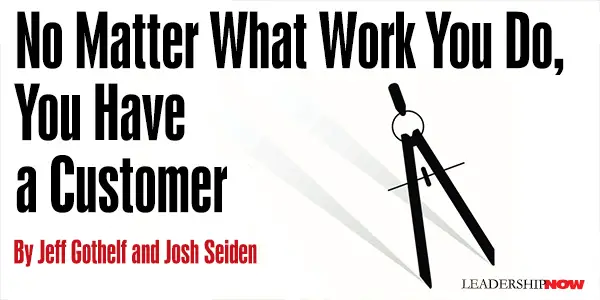 |
 |
06.26.24

No Matter What Work You Do, You Have a Customer
IF SOMEONE was to ask you who is your customer, you would probably easily answer the question. Regardless of what you do at work you probably know who buys the product or service your company makes. Now, if that same someone were to ask you who consumes the work that you personally do, the answer may not come as easily. In a lot of cases, the person who uses what you make isn’t the end customer of your company. It’s likely to be someone who works for your company. What would change if you began to think of that person as your customer? It’s a question most people never consider. How does the work I do make my colleagues more or less successful? It becomes particularly challenging for people working outside of any product development roles. If you work in finance, who uses that spreadsheet you create? What about the legal team? They create policies. How well do those policies enable the work of those who have to follow them? In other words, how well does your work “work?” Making your customers successful defines the value of your work. The simplest way to know if you’ve done that is to see (and measure) how their behavior changes once you’ve delivered your work. Did your spreadsheet reduce or increase the number of questions asked about the budget? Did the procurement policy you implemented decrease or increase vendor onboarding time? These are the true measures of success and value. The act of “making a thing” is just the beginning of the conversation. This is a radical concept. For decades, we’ve been measured by whether or not we “made a thing” or even just completed a task. No one ever asked us if the “thing” we made or the task we completed actually made someone else more successful. The behavior change someone exhibits after using a thing we’ve made is called an outcome. An outcome is a measurable change in human behavior that delivers business results. Outcomes are the fundamental building blocks of objectives and key results (OKRs) — a resurgent, team-focused, goal-setting framework used to redefine success away from the creation of a thing (output) and towards a meaningful change in human behavior (outcome). Imagine you’re a shoe designer. Your work isn’t consumed by the buyers of your company’s shoes. Rather, it’s consumed by materials buyers, merchandisers, marketing and advertising teams, as well as the finance department — not to mention the fabricators of the shoes. Maybe you deliver your designs in the form of a 3D rendering. Maybe you deliver it as a video, or maybe just as a simple PowerPoint presentation. Which delivery channel is best? How do you know? The truth is, you don’t. And that’s the frustratingly ineffective aspect of only considering output alone. You’re guessing. You don’t know exactly what the best way to deliver this information is and which details to include. The most effective way to tell if you’re creating value is to see how people behave. For our shoe designer, the key results that indicate they’ve delivered value include behaviors like “the number of clarifying questions asked after a shoe design is delivered” or “the time it takes to go from design to manufacturing.” These are measures of human behavior. They tell you when you’ve delivered something of value and in a valuable way. They tell you that you’ve made your internal customers successful. When you wrap these key results in a human-centric objective — the benefit these people will get from your work — you set goals that give you a much better sense of the quality of your work and how you might improve it. The shoe designer may put together an objective and key results statement that looks something like this: Objective: Make it dead simple for my colleagues, regardless of department, to do their job from my shoe designs. Key Result: Reduce the number of clarifying questions asked about each design by 90 percent. Key Result: Reduce the time it takes to go from delivered design to manufacturing by 50 percent. Stating goals this way provides the shoe designer with the opportunity to try different ways of delivering their design and assessing which way is best. It makes them a better shoe designer exactly because they’re focusing on their internal colleagues as customers. Use these tips for using OKRs to benefit your internal customers: 1. Think beyond the work that you do. How does what you do enable the next person in line to do their job? Are you making that easier or harder for them with what you’re creating? 2. Talk to your colleagues. Understand how they do their work and what makes it easier and more difficult. Get to know their obstacles. Perhaps there are ways you can help them overcome them. 3. Work with them to determine successful behaviors. How do they define it? Everyone has a customer. It just might not be who you thought. Ask yourself who uses what you make. How do their behaviors indicate that you’ve delivered value to them? Then, write an OKR to redefine your team’s goals and see how that changes the work you produce.  
Posted by Michael McKinney at 01:04 PM
|
BUILD YOUR KNOWLEDGE
 

How to Do Your Start-Up Right STRAIGHT TALK FOR START-UPS 
Grow Your Leadership Skills NEW AND UPCOMING LEADERSHIP BOOKS 
Leadership Minute BITE-SIZE CONCEPTS YOU CAN CHEW ON 
Classic Leadership Books BOOKS TO READ BEFORE YOU LEAD |